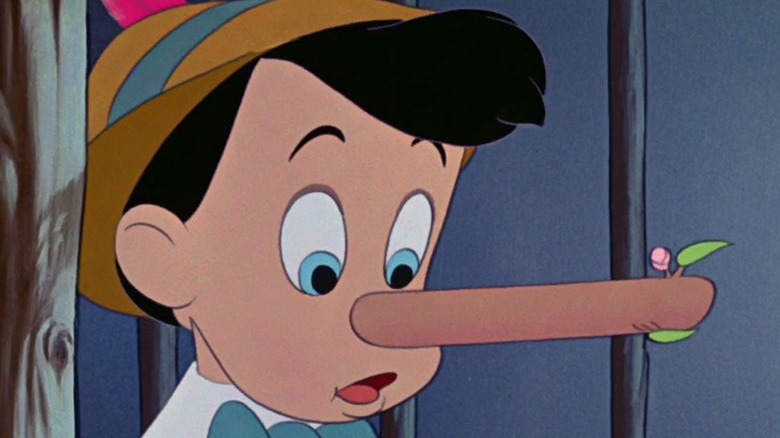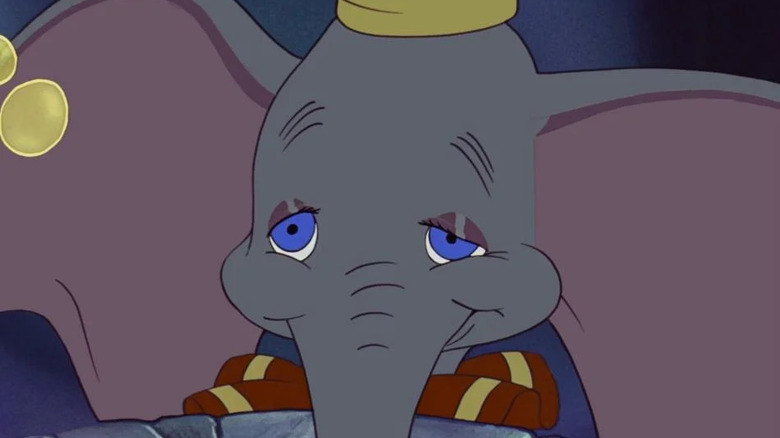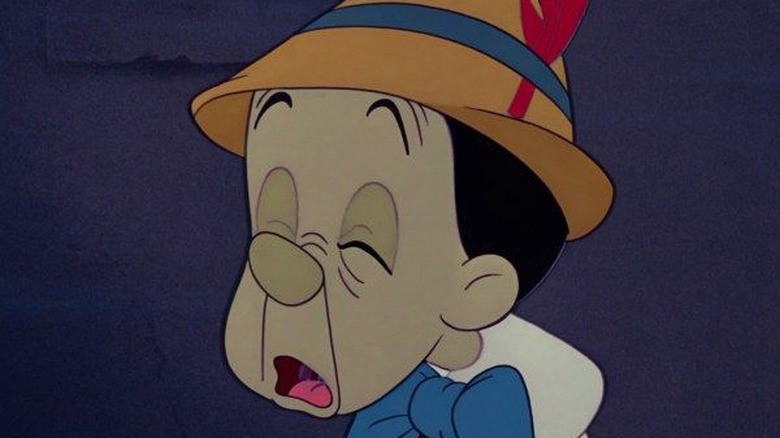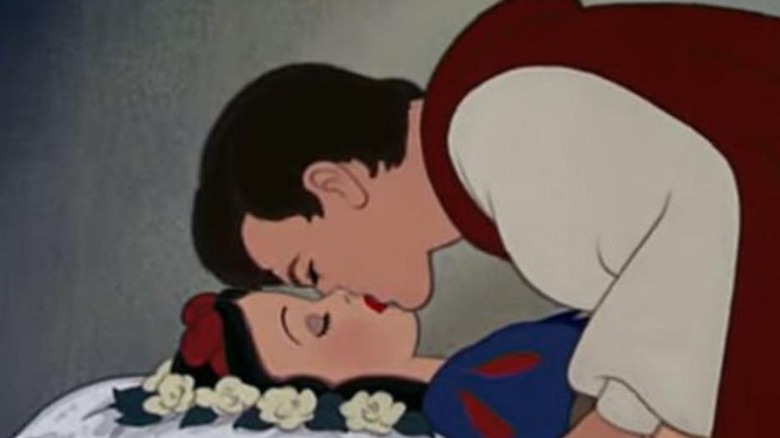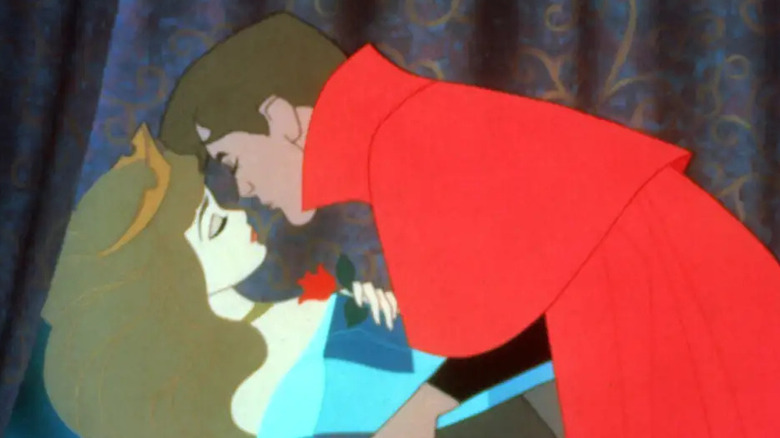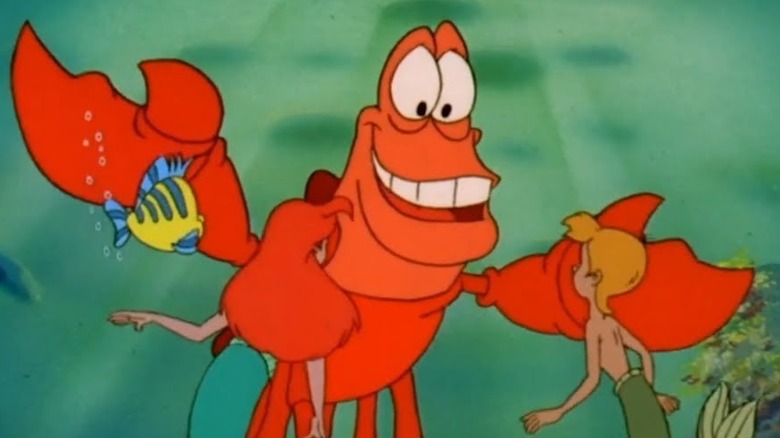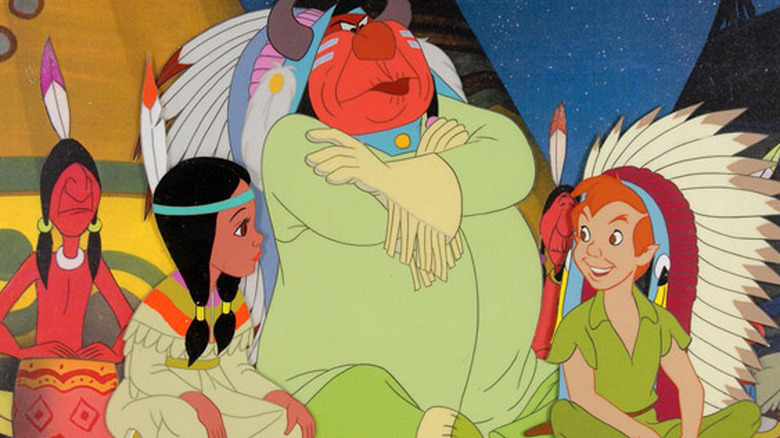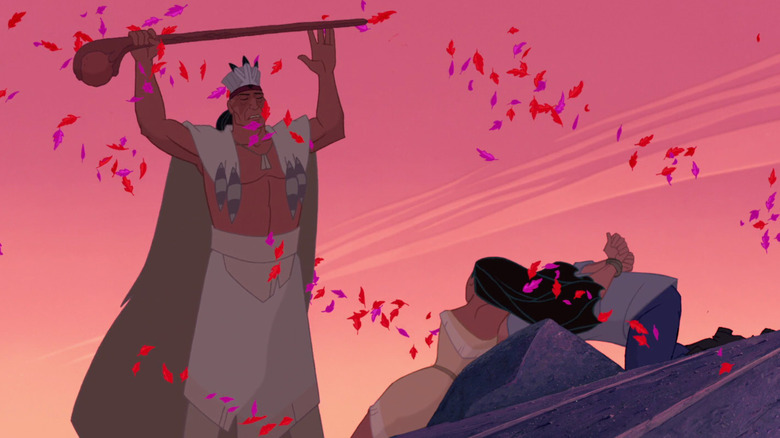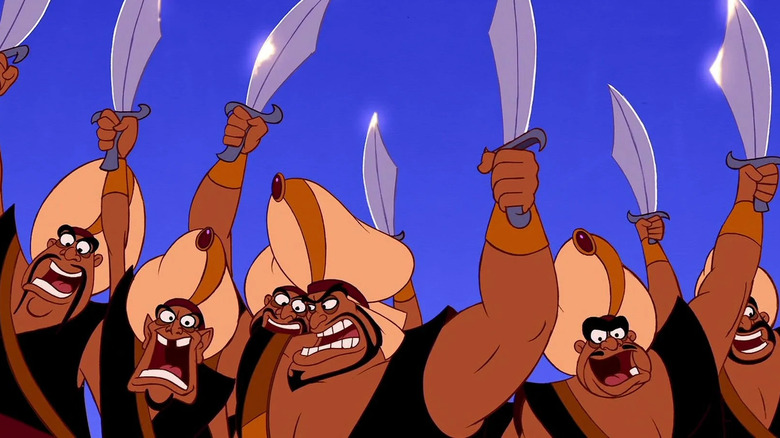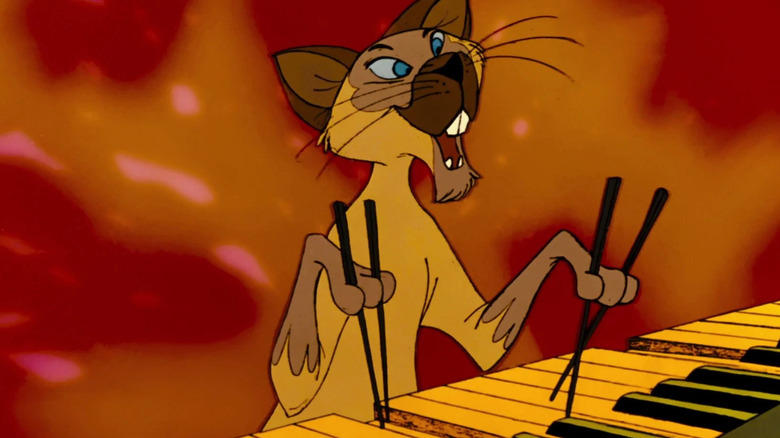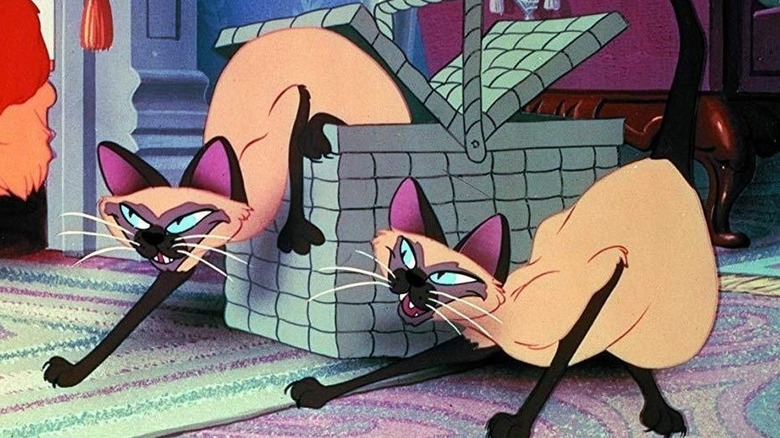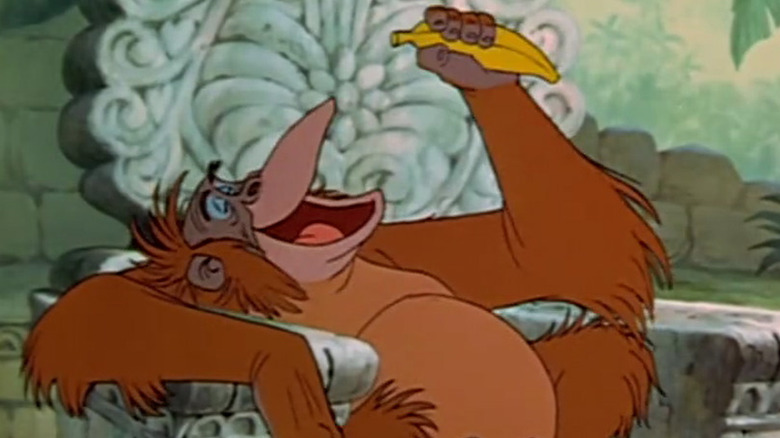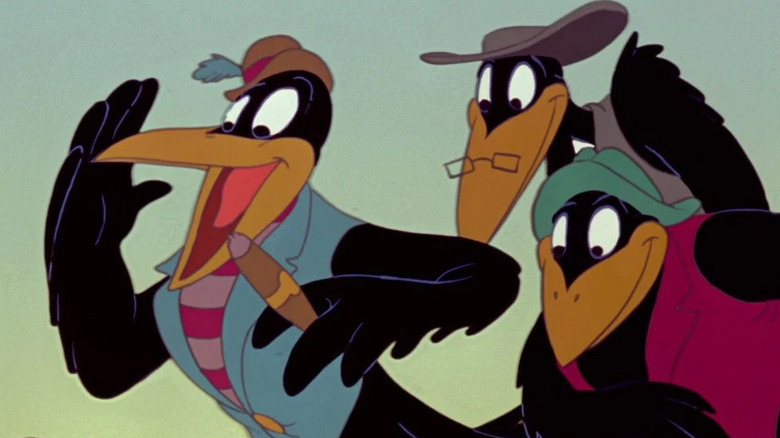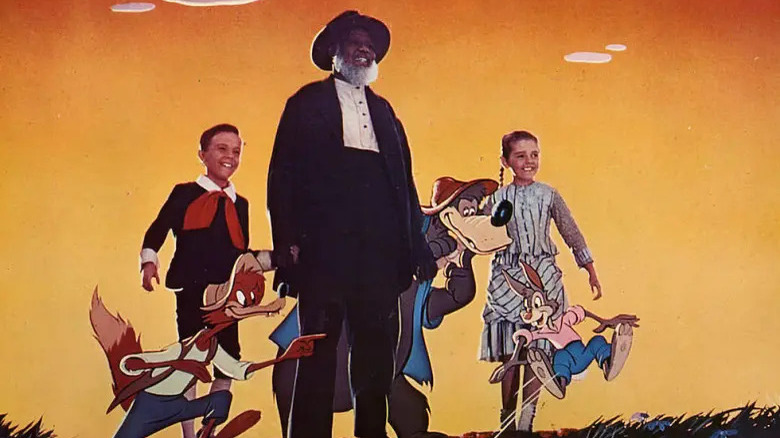Animated Disney Movie Moments That Haven't Aged Well
For more than 80 years, Walt Disney Studios has been synonymous with the term "animated film." Whether we're talking about early Disney classics that helped establish the studio or modern hits that continue to entertain audiences young and old to this day, it's easy to see why Disney has found such a prominent place in the entertainment industry. No matter the decade, the studio has consistently delivered movies that viewers have fallen in love with, setting a high standard for the world of animated film and creating dozens of movies that have defined entire generations of theatergoers.
There's no denying Disney's relevance or the company's impact on pop culture today, with many of its films now considered classics among modern audiences, from the original "Snow White and the Seven Dwarfs" to more recent pop culture phenomenons like "Frozen." Given how long Disney Studios has been around, though, it's not surprising that some elements in their animated catalog have aged very poorly and could be viewed as problematic by modern viewers. Here are some of the most troubling moments in Disney's animated film history.
Underage drinking in Dumbo
It's almost comical to think back to a time when drinking and smoking were portrayed without an issue in children's cartoons. Even more egregious are the occasional instances in which children themselves are shown drinking, such as in "Dumbo."
In that now-famous scene, Dumbo and his best friend/mentor, Timothy Q. Mouse, mistakenly drink from a trough they believe contains water, not knowing that a nearby troupe of clowns have dropped a full bottle of alcohol into it. Lapping up the alcohol-laced water, Dumbo and Timothy quickly become intoxicated and begin hallucinating a variety of pink elephants in a surreal, somewhat disturbing sequence.
As beautifully animated as the pink elephants scene is, the idea of Dumbo — a baby elephant — getting drunk would almost certainly be frowned upon by today's standards, especially given the psychedelic hallucinations shown right afterwards — what was in that alcohol, anyway? Wisely, Tim Burton's 2019 live-action remake omitted the drinking scene, although it kept an altered version of the pink elephants sequence.
Underage drinking and smoking in Pinocchio
"Dumbo" isn't the only movie to feature a Disney protagonist casually getting drunk. Its predecessor, "Pinocchio," similarly features underaged drinking, and depicts young boys smoking, as well.
The scene takes place on Pleasure Island — the seemingly idyllic getaway spot for mischievous young boys where they're free and encouraged to do whatever they want, free of adult supervision. Taking advantage of that freedom, Pinocchio and his newfound friend, Lampwick, engage in numerous frowned-upon activities, including fighting and destroying expensive model homes, before settling back and enjoying a cigar and a beer in Pleasure Island's pool hall.
An argument can be made that "Pinocchio" isn't really glorifying cigar use or alcohol consumption — in the context of the film, such activities as smoking or drinking are proof that the boys are misbehaving, resulting in their turning into donkeys later on. Still, including such a scene at all could be seen as inappropriate, especially given how long it is and how prominently the behavior is displayed.
The famous kiss in Snow White wasn't consensual
One of the most iconic images in all of Disney is the classic ending of "Snow White and the Seven Dwarfs," wherein Prince Charming kisses a comatose Snow White, waking her from "sleeping death" so that the two of them can live happily ever after. It's a simple but satisfactory way to conclude the global phenomenon that was "Snow White" in the 1930s, introducing how "true love's kiss" reigns supreme over even the most powerful or deadly obstacles.
As well-known as the scene is, though, some have pointed out that the kiss does not adhere to today's standards regarding consent when it comes to physical contact between two people. In fact, when Disneyland updated Snow White's attraction in 2021 so that it included the iconic kiss from the film, it generated criticism from publications like SFGATE, whose Julie Tremaine and Katie Dowd wrote, "Haven't we already agreed that consent in early Disney movies is a major issue?"
SFGATE's article on the attraction soon gained increased attention online, sparking some new conversations about old Disney movies when it came to matters of consent. The original film, like the ride itself, remains controversial for this reason.
Sleeping Beauty also ends with a non-consensual kiss
Similar to "Snow White and the Seven Dwarfs," 1959's "Sleeping Beauty" has gained a controversial standing among contemporary Disney audiences, as it ends with Prince Phillip kissing the unconscious Princess Aurora, waking her from her enchanted sleep. As upbeat as the ending of the film is, the idea of a man forcefully kissing a sleeping woman has led to some modern viewers taking issue with it.
Referring to both "Snow White" and "Sleeping Beauty," the education website Middlebury points out that "While many may find this a harmless part of the storylines or a heroic attempt to save the princesses from their possible deaths, it is extremely deleterious to display these interactions that lack blatant consent due to Aurora's and Snow White's inability to speak or disagree in any way." Some upset parents have even asked school districts to pull "Sleeping Beauty" from their classroom's bookshelves because of the potentially inappropriate message it was sending to young children (it should be noted the original fable actually contains a far more disturbing depiction of sexual assault than the significantly toned-down versions that appear in both Grimm's Fairy Tales and the Disney film). However many changes have been made to the presentation of the story over time, though, the ending kiss in "Sleeping Beauty" continues to be seen as every bit as problematic as the ending kiss in "Snow White."
If you or anyone you know has been a victim of sexual assault, help is available. Visit the Rape, Abuse & Incest National Network website or contact RAINN's National Helpline at 1-800-656-HOPE (4673).
Racial undertones in The Little Mermaid
After Walt Disney's death in 1966, Disney's animation studios suffered greatly without his leadership. The studio struggled for the next two decades, consistently putting out movies that failed to live up to the acclaim of their earlier work. That is, until a certain angelic-voiced mermaid swam along, kicking off the Disney Renaissance (a renewed period of critical and commercial success for the studio) and saving the company in the process.
"The Little Mermaid" is a fan favorite and its achievements and success when it was released in 1989 are undeniable. Still, the movie arguably contains racist elements. Some find the character of Sebastian to be troubling, given how heavily rooted the character is in Jamaican stereotypes. These critics also point out how certain underwater creatures appearing in the film seem to be closely related to racist imagery, such as the Blackfish that appears in the song, "Under the Sea," which drew some comparisons to caricatures of Black individuals in the early 1900s. A petition on Change.org was even started to convince Disney to cut the scene from the film, but failed to attract enough petitioners. The scene in question remains in the film to this day.
Peter Pan's racist portrayal of Native Americans
One of the clearest and most shameful displays of racism in past Disney films comes in the form of 1953's "Peter Pan." The now-infamous scene in question depicts Peter and his fellow Lost Boys sitting down with a group of Native Americans who had previously kidnapped them. It utilizes pretty much every stereotype there is in relation to Native Americans, from the clothing, peace pipes, and teepees, to the cliched language usage and hand gestures. Additionally, the scene also involves a racist song, "What Made the Red Man Red," and features the white characters in the film acting out stereotypical mannerisms supposedly related to Native Americans, such as wearing headdresses and making loud whooping noises.
In more recent years, Disney's "Peter Pan" has suffered greatly as a result of this scene, as has the original version of the story written by J.M. Barrie (which contained far more racist portrayals of Native American characters). Non-Disney productions and projects related to "Peter Pan" have either corrected the story's depiction of Native American culture or have avoided the subject altogether, and future "Peter Pan" Disney films would be wise to do the same.
Pocahontas over-simplifies the relationship between Native Americans and English settlers
The issue with "Pocahontas" isn't necessarily one that is rooted in representation — the movie obviously does a far better job depicting Native Americans than something like "Peter Pan," for example. Instead, critics of "Pocahontas" accuse the film of dramatically simplifying the historical relationship between European settlers and the Native Americans whose land they were encroaching upon, presenting a false narrative that ignored how disastrous the settlers' arrival was for the Native American population.
Evidence of historical inaccuracies can be found right from the beginning of the film, in the form of its two protagonists. According to records, the real-life Pocahontas was around 10 years old when she met the 27-year-old John Smith, and the two were likely never romantically involved. Additionally, the movie ending with Pocahontas and Smith's love for one another resolving the conflict between the two sides severely glosses over one major historical fact — namely, that the Europeans would systematically wipe out millions of Native Americans in the coming years. To quote a reader whose comment was cited in The Atlantic, "It's as if the 'Titanic' movie had ended right before the ship sank."
As you might expect, "Pocahontas" wasn't exactly made to be the most historically accurate movie. However, such an oversimplification of Native American/English settler relationships tends to lead people toward inaccurate conclusions about real events, minimizing the negative influence of colonialism and the brutal impact of what has been accurately termed genocide.
Representation of the Arab community in Aladdin
Upon "Aladdin"'s release in 1992, several scholars voiced criticism at the movie's representation of the Arab community. Opponents of the film specifically pointed out the fact that the movie's protagonists, Jasmine and Aladdin, had "Anglicized" physical characteristics and Anglo-American accents, whereas other characters were darker-skinned, spoke with pronounced accents, and were drawn with more "grotesque facial features." As Professor Jack Shaheen wrote for the Los Angeles Times, "'Aladdin' is not an entertaining Arabian Nights fantasy as film critics would have us believe, but rather a painful reminder to 3 million Americans of Arab heritage, as well as 300 million Arabs and others, that the abhorrent Arab stereotype is as ubiquitous as Aladdin's lamp."
The theatrical cut of "Aladdin" faced the harshest criticism, with the American-Arab Anti-Discrimination Committee outraged by the song, "Arabian Nights," which originally contained the lines, "Where they cut off your ear, if they don't like your face / It's barbaric, but hey, it's home." Disney ultimately decided to alter the lyrics in future home video releases of "Aladdin," although the final song still retained the "barbaric" line. Later, "Aladdin" would become one of the movies that included an advisory message on Disney Plus, warning viewers of outdated stereotypes and cultural depictions.
In the 2019 live-action remake of "Aladdin," the lyrics were again reworked and the word "barbaric" was finally removed, with the line now being, "It's chaotic, but hey, it's home."
The Asian cat in The Aristocats
Released in 1970, "The Aristocats" has become something of a cult film among hardcore Disney fans, many of whom see it as being one of the most underrated of Disney's animated movies. However, even when you take into consideration the time frame in which it was made (1970 wasn't exactly the most forward-thinking era in terms of racial representation), the movie contains some shockingly racist scenes that are bound to offend viewers.
"The Aristocats" features a minor character named Shun Gon, an Asian member of the Alley Cats, all of whom are close friends of Thomas O'Malley. The character can be most clearly seen performing a short segment in the song, "Ev'rybody Wants to Be a Cat," playing the piano with chopsticks and singing about fortune cookies in a stereotypical Asian accent.
When you get right down to it, there's really nothing that's not racist about Shun Gon's appearance in "The Aristocats." Drawn with buck teeth and slanted eyes, the character represents one of the most unabashed displays of racism in a Disney movie, and it's still shocking to see to this day.
The Siamese cats in Lady and the Tramp
Predating Shun Gon's appearance in "The Aristocats" are Si and Am, a pair of villainous Siamese cats owned by Aunt Sarah in "Lady and the Tramp," who run amuck in the household and frame Lady for any wrongdoings they commit. With the sound of a gong announcing their entrance, Si and Am are as every bit as racist a caricature as Shun Gon in "The Aristocats," sharing the buck teeth/slanted eyes design and singing their title song "The Siamese Cat Song" with exaggerated accents. Their inclusion in the film is made worse by to the fact that, unlike Shun Gon, they appear in antagonistic roles. Writers like Flavorwire's Marcus Hunter have speculated that the Si and Am's appearance and depiction was likely rooted in anti-Asian sentiment in America following World War II.
Si and Am are completely absent from the live-action remake of "Lady and the Tramp" released in 2019, having been replaced by non-Siamese cats that sing a new song, "What A Shame," in a far less stereotypical manner.
The Jungle Book's King Louie is rooted in stereotypes
"The Jungle Book" may be one of Disney's most memorable movies from the 1960s, but it's also a film that's steeped in quite a bit of controversy. Rudyard Kipling, who wrote the short story collection the movie is based on has gained an increasingly poor reputation due to his support for imperialism and colonialism, openly displayed in his 1899 poem "The White Man's Burden." Moreover, Disney's adaptation of "The Jungle Book" has been accused of perpetuating racial stereotypes — in particular, King Louie, the orangutan monarch (and an original Disney character who didn't appear in the Kipling stories) has come under fire for being an offensive portrayal of Black individuals. For example, Louie and his fellow apes are the only characters to speak in "jive" slang instead of the standard Anglo-American accents the other characters in the film use. Some critics take issue with the fact that Louie sings a song titled "I Want To Be Like You" to the human Mowgli in what The Guardian referred to as "Dixieland style." Others cite the fact that Louie is clearly inspired by Louis Armstrong and seems at times to be a mocking parody of the civil rights movement.
Fortunately, the later live-action adaptation decided to forgo any potential controversy by cutting the "jive" language of the original character and relying on new Louis performer Christopher Walken's signature speaking voice, instead.
Dumbo's negative portrayal of Black characters
There are two scenes in "Dumbo" that contain incredibly racist depictions of Black characters. The first of these has to do with the group of crows who sing the famous song "When I See An Elephant Fly." While the crows ultimately encourage Dumbo to embrace his unique physical characteristics, their appearance, language usage, and even their names are clearly based on Black stereotypes of the time. In the most blatant example, the leader of the crows is named Jim, a pun on "Jim Crow." Originally a 1830s minstrel show character performed by a popular blackface actor, "Jim Crow" quickly became a pejorative for Black people and later referred to a series of laws that severely restricted Black Americans' rights. As The Washington Post's Travis M. Andrews points out, "The main bird, named Jim Crow, was voiced by white actor Cliff Edwards, who engages in the vocal equivalent of blackface."
There's also a scene early in "Dumbo" that shows a group of faceless Black workers laboring in the rain and singing as they work. "Song of the Roustabouts" includes lyrics like "We work all day, we work all night / We never learned to read or write," "We slave until we're almost dead," and "When we get our pay, we throw our money all away," which suggests that these Black workers are content in their lives of hard manual labor. Tim Burton wisely chose to leave both of scenes out of his 2019 remake.
The entirety of Song of the South
What isn't racist about "Song of the South"? It's a movie that's so controversial, Disney has never released it on home video in the United States, nor is it currently available for streaming on Disney Plus (and it almost certainly never will be).
"Song of the South" focuses on the stories of Uncle Remus, an ex-slave still working happily on his old white master's plantation. The film has been accused of portraying slavery and plantation life in the post-Civil War South with a degree of nostalgia, with Black characters like Uncle Remus possessing harmful, stereotypical characteristics. It was considered racist even at the time of its release in 1946 — the NAACP protested it, releasing a statement saying that the movie "perpetuate[s] a dangerously glorified picture of slavery" and "gives the impression of an idyllic master–slave relationship which is a distortion of the facts."
In recent years, Disney has done everything it could to make audiences forget about "Song of the South" — for decades, the only hint that the movie had ever existed (beyond the occasional international home video release, which last happened in the United Kingdom in 2000) was that it served as the premise for Disneyland's famous Splash Mountain attraction. In 2020, though, even that got scrubbed, as Disney officially made the decision to retheme the ride, with "The Princess and the Frog" — the only animated Disney movie to feature a Black princess — serving as the new basis for Splash Mountain.
